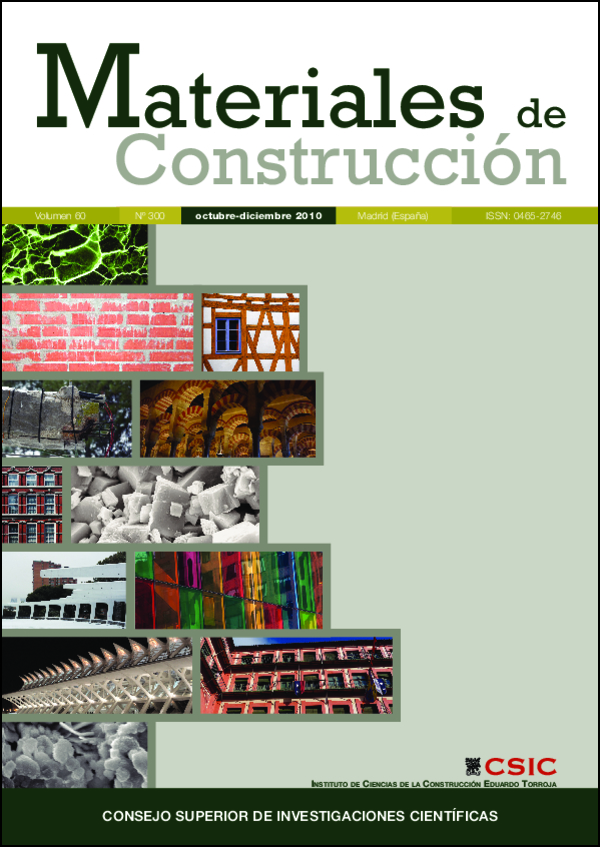Recycling power plant slag for use as aggregate in precast concrete components
DOI:
https://doi.org/10.3989/mc.2010.52109Keywords:
Portland Cement, Slag, Precast Concrete, Alkali-Aggregate Reaction, WorkabilityAbstract
The need to eliminate waste generates costs. When considering the preservation of the environment, the minimization of the consumption of natural resources and energy savings criteria, the need and advisability of studying the feasibility of waste re-use seems clear. However, waste re-use depends on whether they are economically competitive. Therefore, the aim of this study is to evaluate the possible use of slag from a steam power station as aggregate in the manufacture of concrete. This study included the determination of the physical, chemical and thermal properties of the material, comparing the results to those required by the Spanish structural concrete code (EHE) in determining their acceptance or rejection as a concrete component. The ultimate aim of the research was to determine the highest slag content that could be added to concrete without modifying its strength or durability, with a view to obtaining savings in the manufacture of precast structures.
Downloads
References
(1) Aguado, A.; Gettu, R.; Agulló, L.: “La microsílice en el hormigón: una adición de altas prestaciones”, Cemento hormigón, 890 (2006), pp. 56-66.
(2) Molina Bas, O.: “La influencia de las cenizas volantes como sustituto parcial del cemento Portland en la durabilidad del hormigón”, Tesis Doctoral, E.T.S. de Ingenieros de Caminos, Canales y Puertos, Universidad Politécnica de Madrid, 2008.
(3) Rodríguez Santiago, J.: “El empleo de cenizas volantes en la fabricación de hormigones”, Revista de Obras Públicas, 7 (1988), pp. 663-676.
(4) Moanta, A.; Paceagiu, J.; Andreescu, E.; Amzicá, F.: “Escoria de alto horno: una materia prima alternativa utilizada en el proceso de fabricación del clínker Pórtland”l, Cemento hormigón, 890 (2006), pp.16-22.
(5) Acosta, A.; Iglesias, I.; Aineto, M.; Romero, M.; y Rincón, J. M.: “Producción de ladrillos de pasta blanda (por prensado) a partir de escorias de central térmica GICC: Beneficios medioambientales”, Tile & Brick Int. 18 (2002), pp. 8-13.
(6) Ruiz, G.; Iglesias, I. y Acosta, A.: “Comportamiento en fractura de hormigones con escorias GICC”, Anales de mecánica de la fractura, 22 (2005), pp. 571-574.
(7) Aineto, M.; Acosta, A.: “Las escorias de la central térmica GICC ELCOGAS como materia prima para la síntesis de materiales vitrocerámicos. Parte 1: Comportamiento en fusión de las escorias GICC y obtención del vidrio original”, Bol. Soc. Esp. Ceram., V. 44 (2005) pp. 399-404.
(8) Aineto, M.; Acosta, A.; Rincón, J. M. y Romero, M.: “Las escorias de la central térmica GICC ELCOGAS como materia prima para la síntesis de materiales vitrocerámicos. Parte 2: Síntesis y caracterización de los materiales vitrocerámicos”, Bol. Soc. Esp. Ceram., V. 45, (2006), pp. 28-32.
(9) “Instrucción de hormigón estructural (EHE-08)”, BOE 22/08/2008, Spto. nº 203, Ministerio de Presidencia (2008), pp. 96-106, 113, 156.
Downloads
Published
How to Cite
Issue
Section
License
Copyright (c) 2010 Consejo Superior de Investigaciones Científicas (CSIC)

This work is licensed under a Creative Commons Attribution 4.0 International License.
© CSIC. Manuscripts published in both the print and online versions of this journal are the property of the Consejo Superior de Investigaciones Científicas, and quoting this source is a requirement for any partial or full reproduction.
All contents of this electronic edition, except where otherwise noted, are distributed under a Creative Commons Attribution 4.0 International (CC BY 4.0) licence. You may read the basic information and the legal text of the licence. The indication of the CC BY 4.0 licence must be expressly stated in this way when necessary.
Self-archiving in repositories, personal webpages or similar, of any version other than the final version of the work produced by the publisher, is not allowed.
















